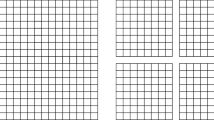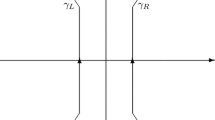Abstract
The anisotropic quantum Heisenberg model with Curie-Weiss-type interactions is studied analytically in several variants of the microcanonical ensemble. (Non)equivalence of microcanonical and canonical ensembles is investigated by studying the concavity properties of entropies. The microcanonical entropy \(s(e,\varvec{m})\) is obtained as a function of the energy \(e\) and the magnetization vector \({\varvec{m}}\) in the thermodynamic limit. Since, for this model, \(e\) is uniquely determined by \({\varvec{m}}\), the same information can be encoded either in \(s(\varvec{m})\) or \(s(e,m_1,m_2)\). Although these two entropies correspond to the same physical setting of fixed \(e\) and \({\varvec{m}}\), their concavity properties differ. The entropy \(s_{{\varvec{h}}}(u)\), describing the model at fixed total energy \(u\) and in a homogeneous external magnetic field \({\varvec{h}}\) of arbitrary direction, is obtained by reduction from the nonconcave entropy \(s(e,m_1,m_2)\). In doing so, concavity, and therefore equivalence of ensembles, is restored. \(s_{{\varvec{h}}}(u)\) has nonanalyticities on surfaces of co-dimension 1 in the \((u,\varvec{h})\)-space. Projecting these surfaces into lower-dimensional phase diagrams, we observe that the resulting phase transition lines are situated in the positive-temperature region for some parameter values, and in the negative-temperature region for others. In the canonical setting of a system coupled to a heat bath of positive temperatures, the nonanalyticities in the microcanonical negative-temperature region cannot be observed, and this leads to a situation of effective nonequivalence even when formal equivalence holds.



Similar content being viewed by others
Notes
Here and in the following Boltzmann’s constant is set to unity.
The derivation in Sect. 3.2.1 of [1] includes a step that is not rigorously justified, namely the rewriting of a product of exponentials of operators as an exponential of a sum of operators in Eq. (38) of [1]. While these two expressions clearly are not equal, it has been proved in Appendix A of [21] that, in a similar situation, the neglected terms do not contribute in the thermodynamic limit to the integral under investigation. While we were not able to adapt this proof to our calculation, it appears plausible that a similar reasoning should also yield the correct result in a microcanonical calculation.
If \(\lambda _1\) happens to be zero, one chooses instead to solve for a magnetization component \(m_\alpha \) corresponding to a nonzero \(\lambda _\alpha \).
With a slight abuse of notation, we use here the same symbol \(s\) for different entropy functions.
The reader be reminded that, according to (8), the energy \(e\) was defined as the interaction energy per spin, but did not include the energy contribution originating from the Zeeman term in the Hamiltonian (1). The total energy (per spin) \(u\) is defined such that it accounts for both contributions.
References
Kastner, M.: Nonequivalence of ensembles in the Curie–Weiss anisotropic quantum Heisenberg model. J. Stat. Mech. 2010, P07006 (2010)
Micheli, A., Brennen, G.K., Zoller, P.: A toolbox for lattice-spin models with polar molecules. Nat. Phys. 2, 341–347 (2006)
Britton, J.W., Sawyer, B.C., Keith, A.C., Wang, C.C.J., Freericks, J.K., Uys, H., Biercuk, M.J., Bollinger, J.J.: Engineered two-dimensional Ising interactions in a trapped-ion quantum simulator with hundreds of spins. Nature 484, 489–492 (2012)
Friedenauer, A., Schmitz, H., Glueckert, J.T., Porras, D., Schaetz, T.: Simulating a quantum magnet with trapped ions. Nature Phys. 4, 757–761 (2008)
Islam, R., Edwards, E.E., Kim, K., Korenblit, S., Noh, C., Carmichael, H., Lin, G.D., Duan, L.M., Wang, C.C.J., Freericks, J., Monroe, C.: Onset of a quantum phase transition with a trapped ion quantum simulator. Nat. Commun. 2, 377 (2011)
Lanyon, B.P., Hempel, C., Nigg, D., Müller, M., Gerritsma, R., Zähringer, F., Schindler, P., Barreiro, J.T., Rambach, M., Kirchmair, G., Hennrich, M., Zoller, P., Blatt, R., Roos, C.F.: Universal digital quantum simulation with trapped ions. Science 334, 57–61 (2011)
Grossmann, S., Holthaus, M.: Microcanonical fluctuations of a Bose system’s ground state occupation number. Phys. Rev. E 54, 3495–3498 (1996)
Kastner, M.: Nonequivalence of ensembles for long-range quantum spin systems in optical lattices. Phys. Rev. Lett. 104, 240403 (2010)
Ruelle, D.: Statistical Mechanics: Rigorous Results. Benjamin, Reading (1969).
Touchette, H., Ellis, R.S., Turkington, B.: An introduction to the thermodynamic and macrostate levels of nonequivalent ensembles. Physica A 340, 138–146 (2004)
Lynden-Bell, D., Wood, R.: The gravo-thermal catastrophe in isothermal spheres and the onset of red-giant structure for stellar systems. Mon. Not. R. Astron. Soc. 138, 495–525 (1968)
Thirring, W.: Systems with negative specific heat. Z. Phys. 235, 339–352 (1970)
Pflug, A.: Gravitating fermions in an infinite configuration space. Commun. Math. Phys. 78, 83–98 (1980)
Giansanti, A., Moroni, D., Campa, A.: Universal behaviour in the static and dynamic properties of the \(\alpha \)-\({XY}\) model. Chaos Soliton Fract. 13, 407–416 (2002)
Pearce, P.A., Thompson, C.J.: The anisotropic Heisenberg model in the long-range interaction limit. Commun. Math. Phys. 41, 191–201 (1975)
Mori, T.: Instability of the mean-field states and generalization of phase separation in long-range interacting systems. Phys. Rev. E 84, 031128 (2011)
Mori, T.: Equilibrium properties of quantum spin systems with nonadditive long-range interactions. Phys. Rev. E 86, 021132 (2012)
Touchette, H.: Ensemble equivalence for general many-body systems. Europhys. Lett. 96, 50010 (2011)
Touchette, H.: Methods for calculating nonconcave entropies. J. Stat. Mech. 2010, P05008 (2010)
Gibbs, J.W.: Elementary Principles in Statistical Mechanics. Charles Scribner’s Sons, New York (1902)
Tindemans, P.A.J., Capel, H.W.: An exact calculation of the free energy in systems with separable interactions. Physica 72, 433–464 (1974)
Miller, P.D.: Applied Asymptotic Analysis, Graduate Studies in Mathematics, vol. 75. American Mathematical Society, Providence (2006)
Campa, A., Ruffo, S., Touchette, H.: Negative magnetic susceptibility and nonequivalent ensembles for the mean-field \(\varphi ^4\) spin model. Physica A 385, 233–248 (2007)
Ellis, R.S., Haven, K., Turkington, B.: Large deviation principles and complete equivalence and nonequivalence results for pure and mixed ensembles. J. Stat. Phys. 101, 999–1064 (2000)
Casetti, L., Kastner, M.: Partial equivalence of statistical ensembles and kinetic energy. Physica A 384, 318–334 (2007)
Kastner, M.: Microcanonical entropy of the spherical model with nearest-neighbour interactions. J. Stat. Mech. 2009, P12007(1–15) (2009).
Kastner, M., Pleimling, M.: Microcanonical phase diagrams of short-range ferromagnets. Phys. Rev. Lett. 102, 240604(1–4) (2009).
Acknowledgments
We acknowledge useful comments by an anonymous referee who correctly pointed out to us that certain steps in derivation of the microcanonical entropy in Ref. [1] and also in the present paper are not rigorously justified. G.O. acknowledges financial support by the National Institute for Theoretical Physics, South Africa, and the Institute of Theoretical Physics, Stellenbosch University, South Africa, where he was based for the majority of this study. M.K. acknowledges support by the Incentive Funding for Rated Researchers program of the National Research Foundation of South Africa.
Author information
Authors and Affiliations
Corresponding author
Appendix: Evaluation of \(\fancyscript{F}\) at the Stationary Points
Appendix: Evaluation of \(\fancyscript{F}\) at the Stationary Points
It is shown how to evaluate \(\fancyscript{F}\) as given in (20) at a stationary point determined by equations (18a)–(18c).
We start by writing (18b) in the form
Upon squaring, summing over \(\alpha \), and then taking the square root on both sides of this equation, we obtain
where the second equality sign is due to definition (19). We therefore have \(\tanh r=|\varvec{m}|\) and can write
The first two terms on the right hand side of (41) can be written in the form
where first (18a) and then (18c) have been used. With (39) and (40), this expression simplifies to
Inserting this into (41), the derivation of (21) is complete.
Rights and permissions
About this article
Cite this article
Olivier, G., Kastner, M. Microcanonical Analysis of the Curie–Weiss Anisotropic Quantum Heisenberg Model in a Magnetic Field. J Stat Phys 157, 456–473 (2014). https://doi.org/10.1007/s10955-014-1093-9
Received:
Accepted:
Published:
Issue Date:
DOI: https://doi.org/10.1007/s10955-014-1093-9




